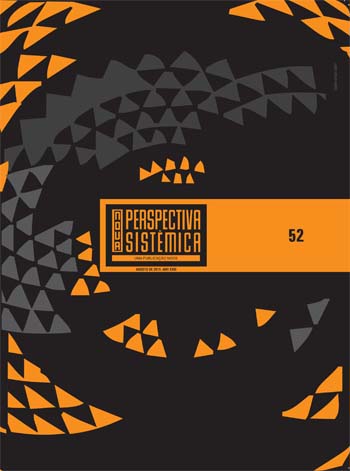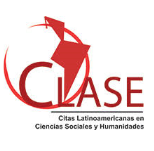Família como realização discursiva: uma explicação relacional
Palavras-chave:
família, relações familiares, terapia familiar, teoria psicológica, construcionismo social.Resumo
Partindo de um entendimento de família como construção social, este artigo sugere que as pessoas ativamente produzem sentidos sobre família no intercâmbio social. A ideia é que família pode ser concebida como uma realização discursiva: Família é definida em termos do que as pessoas, utilizando-se de diferentes discursos socialmente produzidos disponíveis, descrevem juntas como sendo família. Propomos que diferentes realidades sobre família são criadas por meio de processos de negociação de sentidos no momento interativo. Portanto, há muitas versões diferentes de família e cada uma delas tem implicações diversas para o mundo social. Exemplos dessas implicações para as teorias psicológicas, pesquisa e terapia familiar são apresentados, considerando como podem ser úteis para o campo da psicologia.
Downloads
Referências
Ackerman, N. W. (1958). The psychodynamics of family life: Diagnosis and treatment of family relationships. New York: Basic Books.
Anderson, H. (1997). Conversation, language and possibilities: A post-modern approach to therapy. New York: Basic Books.
Anderson, H. (2012). Collaborative relationships and dialogic conversations: Ideas for a relationally responsive practice. Family Process, 51, 8-24. doi: 10.1111/j.1545-5300.2012.01385.x
Anderson, H., & Goolishian, H. (1988). Human systems as linguistic systems: Preliminary and evolving ideas about the implications for clinical theory. Family Process, 27, 371-393. doi: 10.1111/j.1545-5300.1988.00371.x
Becvar, D. S. (2003). Eras of Epistemology: A Survey of Therapy Thinking and Theorizing. In T. L. Sexton, G. R. Weeks, & M. S. Robbins (Eds.), Handbook of Family Therapy: The science and practice of working with families and couples (pp. 3-22). New York: Routledge.
Carsten, J. (2000). Introduction: Cultures of relatedness. In J. Carsten (Ed.), Cultures of relatedness: New approaches to the study of kinship (pp. 1-36). Cambridge, UK: Cambridge University Press.
Chatters, L. M., Taylor, R. J., & Jayakody, R. (1994). Fictive kinship relations in black extended families. Journal of Comparative Family Studies, 25, 297-312.
Doherty, W. J. (1999). Postmodernism and Family Theory. In M. B. Sussman, S. K. Steinmetz, & G. W. Peterson, Handbook of marriage and the family (pp. 205-217). New York: Springer.
Fonseca, C. (2007). Apresentação. De família, reprodução e parentesco: Algumas considerações. Cadernos Pagu, 29, 9-35. doi: 10.1590/S0104-83332007000200002.
Foucault, M. (1969). The archaeology of knowledge. (Trans. A. M. Sheridan Smith). London and New York: Routledge.
Frank, A. (2005). What is dialogical research, and why should we do it? Qualitative Health Research, 15, 964-974. doi: 10.1177/1049732305279078.
Gergen, K. J. (1997). Realities and relationships. Cambridge, MA: Harvard University Press.
Gergen, M. M., & Davis, S. N. (1997). Toward a new psychology of gender: Opening conversations. In M. M. Gergen, & S. N. Davis (Eds.), Toward a new psychology of gender: A Reader (pp. 1-27). New York: Routledge.
Gulbrium, J. F., & Holstein, J. A. (1990). What is family? Moutain View, CA: Mayfield Publishing Company.
Hacking, I. (1999). Why ask what. In I. Hacking, The social construction of what? (pp. 01-34). Cambridge, MA: Harvard University Press.
Hess, R. D., & Handel, G. (1959). Family worlds. Chicago: Chicago University Press.
Jackson, D.D. (Ed.)(1968a). Therapy, Communication, and Change. Palo Alto, CA: Science and Behavior Books, Inc.
Jackson, D.D. (Ed.)(1968b). Communication, family, and marriage. Palo Alto, CA: Science and Behavior Books, Inc.
Lloyd, S. A., Few, A. L., & Allen, K. R. (2009). Handbook of Feminist Family Studies. London: SAGE Publications.
Maturana, H., & Varela, F. (1992). The tree of knowledge: The biological roots of human understanding (revised ed.). Boston: Shambhala.
McLain, R., & Weigert, A. (1979). Toward a phenomenological sociology of family: A pragmatic essay. In W. R. Burr, R. Hill, F. I. Nye, & I. L. Reiss (Eds.), Contemporary theories about the family: General theories/Theoretical Orientations (Vol. 2, pp. 160-205). New York: Free Press.
McNamee, S. (2004). Promiscuity in the practice of family therapy. Journal of Family Therapy, 26, 224-244. doi: 10.1111/j.1467-6427.2004.00280.x
McNamee, S. (2010). Research as social construction: Transformative Inquiry. Health & Social Change, 1(1), 09-19.
Scharff, J. S., & Scharff, D. E. (2003). Object-Relations and Psychodinamic Approaches to Couple and Family Therapy. In T. L. Sexton, G. R. Weeks, & M. S. Robbins (Eds.), Handbook of Family Therapy: the science and practice of working with families and couples (pp. 66-92). New York: Routledge.
Shotter, J. (2008). Conversational realities revisited: Life, language, body and world. Chagrin Falls, Ohio: Taos Institute Publications.
Shotter, J. (2009). Listening in a way that recognizes/realizes the world of the ‘other’. International Journal of Listening, 23, 21-43. doi: 10.1080/10904010802591904.
Silverstein, L. B., & Auerbach, C. F. (1999). Deconstructing the essential father. American Psychologist, 54, 397-406. doi: 10.1037/0003-066X.54.6.397
Stacey, J. (1990). Brave new families: Stories of domestic upheaval in late-Twentieth-Century America. Berkeley, CA: University of California Press.
Stack, C. B. (1974). All our kin. New York: Harper & Row.
Thorne, B. (1992). Feminism and the family: Two decades of thought. In B. Thorne, & M. Yalom (Eds.), Rethinking the family: Some feminist questions (pp. 3-30). Boston: Northeastern University Press.
Thorne, B., & Yalom, M. (Eds.) (1992). Rethinking the family: Some feminist questions. Boston: Northeastern University Press.
Vaitsman, J. (1995). Indivíduo, casamento e família em circunstâncias pós-modernas. Dados (Rio de Janeiro), 38(2), 329-352.
Von Foerster, H. (1981). Observing systems. Seaside, CA: Intersystems Publications.
Watarai, F., & Romanelli, G. (2009). Stepfamilies among Brazilian Low-income Classes:
Relationships and Roles. The International Journal of Interdisciplinary Social Sciences, 4(7), 235-246.
Wittgenstein, L. (1953). Philosophical investigations (G.E.M. Anscombe, Trans.). New York: Macmillan
Downloads
Como Citar
Edição
Seção
Licença
Autores que publicam nesta revista concordam com os seguintes termos:- Autores mantém os direitos autorais e concedem à revista o direito de primeira publicação, com o trabalho licenciado simultaneamente sob uma Licença Creative Commons Attribution após a publicação, permitindo o compartilhamento do trabalho com reconhecimento da autoria do trabalho e publicação inicial nesta revista.
- Autores têm autorização para assumir contratos adicionais separadamente, para distribuição não-exclusiva da versão do trabalho publicada nesta revista (ex.: publicar em repositório institucional ou como capítulo de livro), com reconhecimento de autoria e publicação inicial nesta revista.
- Autores têm permissão e são estimulados a publicar e distribuir seu trabalho online (ex.: em repositórios institucionais ou na sua página pessoal) a qualquer ponto antes ou durante o processo editorial, já que isso pode gerar alterações produtivas, bem como aumentar o impacto e a citação do trabalho publicado (Veja O Efeito do Acesso Livre).

















